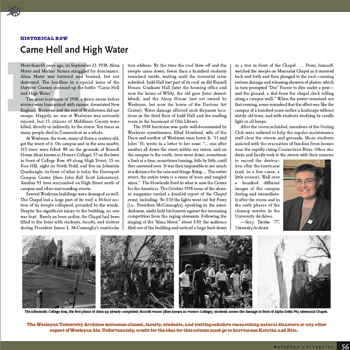HISTORICAL ROW: CAME HELL AND HIGH WATER
 More than 65 years ago, on September 21, 1938, Alma Mater and Mother Nature struggled for dominance. Alma Mater was battered and bruised, but not destroyed. The headline in a special issue of the Hartford Courant summed up the battle: “Came Hell and High Water.”
More than 65 years ago, on September 21, 1938, Alma Mater and Mother Nature struggled for dominance. Alma Mater was battered and bruised, but not destroyed. The headline in a special issue of the Hartford Courant summed up the battle: “Came Hell and High Water.”
The great hurricane of 1938, a fierce storm before storms were humanized with names, devastated New England. Wesleyan and the rest of Middletown did not escape. Happily, no one at Wesleyan was seriously injured, but 15 citizens of Middlesex County were killed, directly or indirectly, by the storm. Ten times as many people died in Connecticut as a whole.
At Wesleyan, the trees, many of them a century old, got the worst of it. On campus and in the area nearby, 315 trees were felled: 88 on the grounds of Russell House (then known as Honors College), 57 on the lawn in front of College Row, 49 along High Street, 15 on Foss Hill, eight on North Field, and five on Johnston Quadrangle, in front of what is today the Davenport Campus Center (then John Bell Scott Laboratory). Another 93 trees succumbed on High Street north of campus and other surrounding streets.
Several Wesleyan buildings were damaged as well. The Chapel lost a large part of its roof; a 30-foot section of its steeple collapsed, pounded by the winds. Despite the significant injury to the building, no one was hurt. Barely an hour earlier, the Chapel had been filled to the brim with students, faculty, and visitors during President James L. McConaughy’s matriculation address. By the time the roof blew off and the steeple came down, fewer than a hundred students remained inside, waiting until the torrential rains subsided. Judd Hall lost part of its roof, as did Russell House, Graduate Hall (later the housing office and now the home of WSA), the old gym (later demolished), and the Alsop House (not yet owned by Wesleyan, but now the home of the Davison Art Center). Water damage affected such disparate locations as the third floor of Judd Hall and the reading room in the basement of Olin Library.
The 1938 hurricane was quite well-documented by Wesleyan eyewitnesses. Ethel Howland, wife of the Dean and mother of Wesleyan men Leroy Jr. ’31 and John ’35, wrote in a letter to her sons: “a?| one after another all down the street within my vision, and on the campus to the south, trees went down, sometimes a limb at a time, sometimes leaning, little by little, until they careened over. It was then impossible to see much at a distance for the rain and things flying a?| The entire street, the entire town is a mess of trees and tangled wires.” The Howlands lived in what is now the Center for the Americas. The October 1938 issue of the alumni magazine carried a detailed report of the Chapel event, including: “At 3:10 the lights went out but Prexy [i.e., President McConaughy], speaking in the semi-darkness, easily held his hearers against the increasing competition from the raging elements. Following the singing of the “Alma Mater,” about 3:30, the audience filed out of the building and noticed a large limb down in a tree in front of the Chapel . . . Prexy, himself, watched the steeple on Memorial Chapel as it wavered back and forth and then plunged to the roofa??causing serious damage and releasing showers of plaster, which in turn prompted “Doc” Fauver to dive under a pewa??and the ground, a dial from the chapel clock rolling along a campus walk.” When the power remained out that evening, some remarked that the effect was like the campus of a hundred years earlier: a landscape without stately old trees, and with students studying by candle light or oil lamps.
After the storm subsided, members of the Outing Club were enlisted to help the regular maintenance staff clear the streets and grounds. Many students assisted with the evacuation of families from homes near the rapidly rising Connecticut River. Other students and faculty took to the streets with their cameras to record the destruction after the hurricane (and, in a few cases, a little sooner). Well over a hundred different images of the campus during and immediately after the storm and in the early phases of the cleanup survive in the University Archives.
Suzy Taraba ’77, University Archivist
